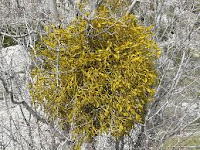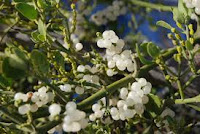European mistletoe or Viscum album is less toxic than its American counterpart, and this article refers only to the European variety. All information here is just that and if anyone cares to use the treatments then they should only do so under strict medical supervision. Mistletoe remedies are not for pregnant or lactating women and children should be actively discouraged from eating the berries.
There are around 1,400 species of mistletoe that grow around the world, and Viscum album is divided into 4 subspecies, three of which occur in Europe and one in Asia.
Of course, whether in Britain or the US, people know the tradition of kissing under branches of mistletoe at Christmas time when it decorates houses. This tradition stems from an ancient Scandinavian legend, when one of the gods, Balder was slain by an arrow made from mistletoe wood. The other deities prayed for his resurrection and their prayers were answered. Mistletoe was then kept in the care of the Goddess of Love and it was decreed that anyone passing under mistletoe should receive a kiss, symbolizing that it was a plant of love and peace not of hate.
We also know from Pliny the Elder that mistletoe was harvested by the Druids in northern Europe. They only cut it when the moon was in a certain phase at the beginning of the New Year and cut mistletoe from the oak tree, which was especially revered by them because of its life-giving properties, as were the plants such as mistletoe and the oak apples that grew on it. They believed that mistletoe was a universal healer and used it in many potions. They also believed that it would protect from all evils and this is probably why we decorate our homes with it to this day. Druids used mistletoe to reach the other world in their shamanic rites and also used it in human sacrifices. Today modern “Druids” gather in orchards in Herefordshire, UK to celebrate the mistletoe in December, probably much to the consternation of farmers whose orchards they congregate in. Ancient Druids would gather mistletoe by cutting it with a golden sickle and laying it on white sheets under the oak trees from which it had been cut. They only cut the mistletoe after they had been told to cut it in visions, and would sing under the trees before they climbed them to harvest the mistletoe. Ovid writes “Ad viscum Druidae cantare solebant.”(The Druids would solemnly sing to the mistletoe.) The Druids sent young acolytes to dwellings carrying branches of mistletoe to herald the New Year.
Now mistletoe should be burned, according to an old superstition, on Twelfth Night, or all the boys and girls who kissed under it will never marry. At one time it was also believed to cause sterility.
In his play “Titus Andronicus” Shakespeare called it “the baleful mistletoe,” probably because he knew the old legend and because it was considered poisonous.
Today mistletoe is rarely found on oak trees, but is most commonly found on old apple trees, although curiously not on pear trees. It also grows on ash trees, hawthorns and willows, among others. It is usually deposited by birds, notably the Missel Thrush which avidly devours the berries, and probably got its name from this predilection. It can also be “planted” on trees by rubbing the berries on the bark or the underside of branches, although birds are the best way of propagating mistletoe, farmers believe.
European mistletoe is a true parasite and only grows on a living tree, not on decayed fallen bark as fungi can. Other mistletoes are not all true parasites. Viscum album grows a thick, woody root and has yellow calyxes in May, but the berries don’t fully ripen until December. The twigs and leaves (but not the berries) have been used as sheep fodder in winter.
In Brittany mistletoe is known as the Herb of the Cross (Herbe de la Croix) as it is said that the wood of the mistletoe was used to make Christ’s cross, and was so demoted in the plant world and doomed to become a parasite. Mistletoe wood has been used as a protection from evil and epileptic fits since Druidic times, however.
Traditionally mistletoe leaves and twigs have been used to cure numerous ailments, among them hysteria, convulsions of delirium, for stopping internal haemorrhages, neuralgia, urinary disorders, heart disease, other problems related to the nervous system and as an aphrodisiac. Sir John Colbatch wrote a medical pamphlet in 1720 extolling the virtues of mistletoe as a cure for epilepsy, “The Treatment of Epilepsy by Mistletoe.” It was also used as a remedy for St. Vitus’ dance, and was often mixed with valerian root and vervain to treat nervous complaints. Cayenne peppers were added to this mixture for treating digestive disorders. Large quantities of mistletoe could aggravate the disorders it was supposed to treat however.
 The birdlime from the berries has been used to treat sores and ulcers and a berry was believed to relieve stitches in sides.
The birdlime from the berries has been used to treat sores and ulcers and a berry was believed to relieve stitches in sides. You can make a cold water infusion with the chopped leaves and twigs by putting 2-4 tsp (10-20 gr) dried or fresh leaves into 500 ml of cold water and leaving them to steep overnight. Sweeten with honey and drink when you wake up. During the day steep more leaves in cold water and drink at bedtime. A tisane may be made with 1 tsp (5 gr) chopped leaves to 250 ml boiling water, and leaving this mixture to steep for 10-15 mins before straining and drinking. You can have 2 cups a day.
Modern medical trials have shown that an extract of mistletoe when injected into the blood stream regularly can help in the treatment of bowel cancer as it can lower the effects of chemo and radiotherapy. It is believed that it acts upon the immune system, helping to prevent tumours spreading and to expel the toxic substances that build up in the body after the therapies. Those who underwent treatment with mistletoe extract survived for longer than patients who were not given the treatment, and they experienced fewer side effects from the therapies.
 Mistletoe contains lignans which are used as chemopreventives as well as to lower cholesterol levels and treat atherosclerosis. These are also found in flax seeds, pumpkin seeds and cranberries. It also contains acetylcholine which is involved in the transmission of nerve impulses in the body. There are also lectins or viscotoxins present, which behave in a similar way to snake venom. Bioflavonoids such as quercetin are also present in mistletoe and so it can help lower blood pressure and heart rate as well as ease anxiety and promote sleep.
Mistletoe contains lignans which are used as chemopreventives as well as to lower cholesterol levels and treat atherosclerosis. These are also found in flax seeds, pumpkin seeds and cranberries. It also contains acetylcholine which is involved in the transmission of nerve impulses in the body. There are also lectins or viscotoxins present, which behave in a similar way to snake venom. Bioflavonoids such as quercetin are also present in mistletoe and so it can help lower blood pressure and heart rate as well as ease anxiety and promote sleep. It is also thought that mistletoe may help improve blood sugar levels in people with diabetes, so perhaps the Druids weren’t wrong when they thought of this parasite as a universal healer.






I like your information which is very useful for me. Thanks.
ReplyDeleteUniversal Healer
Top Astrologer
Powerful Astrologer
Pandit Bhushan
Astrologer